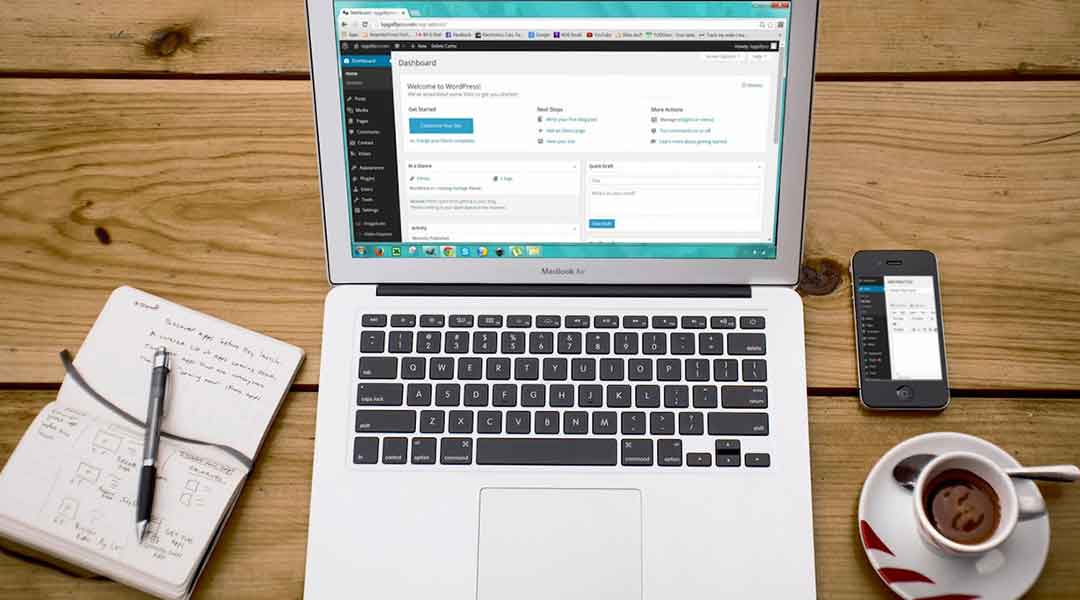Establishing an online presence is crucial for success in the present-day digital landscape. A website is ideal for showcasing products and services or disseminating information. WordPress stands out for its ease of use, adaptability, and extensive feature set among the web design tools available.
Recent data indicates that WordPress commands a substantial 34% market share on the web, a figure that continues to grow steadily.
Regardless of whether you operate a small business, are an enterprising individual, or engage in blogging, you can likely derive significant advantages from harnessing the capabilities of a WordPress website.
1. Define Your Site’s Purpose and Strategy
Begin by establishing the purpose and strategic direction for your website.
The initial stage of any web design endeavor entails defining the primary objective of your site. What specific outcomes do you intend to achieve through your website?
Are you engaged in selling products or services? In such cases, an eCommerce platform becomes indispensable. Is your primary goal to generate leads? Then you’ll require a contact form and an effective lead-capturing mechanism. Perhaps you aim to disseminate information? In that case, a blog or news site might prove more suitable.
Broadly speaking, there exist three distinct categories of WordPress websites:
- Business websites: Typically employed for the purpose of product or service sales, these websites frequently incorporate eCommerce functionalities, contact forms, and systems for lead capture.
- Portfolio websites: Designed to exhibit the work of an individual or a team, these websites usually feature a gallery, project pages, and a contact form.
- Blogs: Utilized for sharing articles, news, or personal viewpoints, blogs typically encompass a blogroll, seamless integration with social media platforms, and RSS feeds.
Irrespective of your specific goals, it remains crucial to formulate a well-defined strategy. This strategic approach will guide you in determining your website’s requisite content and features.
2. Choose Your Website Platform
After you have defined your purpose and strategy, it’s time to choose a suitable platform. Numerous web design platforms are available; among them, WordPress stands out as a popular choice.
WordPress is a content management system (CMS) that simplifies website creation and management. It boasts a user-friendly interface and offers a wide range of themes and plugins to enhance functionality.
WordPress powers a significant percentage, nearly 20%, of websites worldwide. Therefore, it is an excellent option if you desire a widely adopted platform. By utilizing WordPress, you can design a distinctive website without the need to code everything from scratch.
Here’s the process to commence designing your website using WordPress:
Name your website
Naming your website is an important and relatively simple task. However, it is crucial to consider that this name will become the identifier for your brand. Therefore, make your selection thoughtfully.
You can utilize tools like Namecheap, GoDaddy, or Hover to discover an appropriate domain name for your website.
Acquire a domain and hosting
The subsequent step involves acquiring a domain and web hosting to provide storage space for your website’s files.
Several web hosting providers are available, but we recommend Bluehost. They are one of the largest web hosting companies globally and offer a complimentary domain when you sign up for their hosting services.
Their plans begin at $2.95 per month, ideal if you are just starting out.
Set up WordPress
Next, you need to install WordPress. This can be accomplished automatically through your web hosting panel or manually.
If you opt for Bluehost, access your customer profile and locate the “My Sites” tab. From there, you can specify the domain name for your new site and the username and password you will use on WordPress.
Once the installation wizard completes the process, your site will be ready for customization
Set permalinks on WordPress
Permalinks are the permanent URLs to your individual blog posts and web pages. By default, WordPress permalinks look like this: http://example.com/?p=123
This is not very user-friendly or SEO-friendly. Fortunately, WordPress makes it easy to change your permalinks.
We recommend using the “Post name” permalink structure, which will look like this: http://example.com/sample-post/
To change your permalink structure, go to Settings » Permalinks and select “Post name” from the Common Settings section. Don’t forget to click on the “Save Changes” button to store your settings.
Make your WordPress website public
If you’re running a business website, it’s important to make sure your site is public. That way, people can find and visit your site.
To make your WordPress site public, go to Settings » Reading and uncheck the box next to “Discourage search engines from indexing this site.”
Set title and tagline
Title and taglines are used to identify your website. The title is typically displayed in the browser tab, while the tagline is used to describe your site.
You can set your title and tagline by going to Settings » General. In the fields marked “Site Title” and “Tagline,” enter the title and tagline you want to use.
The title and tagline can appear in multiple places throughout your website, depending on your chosen theme. It will also be in the SEO description used by Google when listing your site in search results.
The tagline is not mandatory, so you can leave it blank if you don’t need one.
Allow or disable comments, pingbacks, etc.
Comments can be a great way to engage with your website visitors. However, they can also be a source of spam.
To allow or disable comments, pingbacks, and trackbacks, go to Settings » Discussion. Under the “Default article settings” section, you can choose whether you want to allow people to comment on your posts or not. If you uncheck the box next to “Allow people to post comments on new articles,” comments will be turned off globally. However, you can still allow comments on individual posts and pages.
If you’re not sure whether you want to allow comments or not, we recommend leaving them turned on for now and moderating the comments that come in. That way, you can decide whether the comments are valuable or not.
Set your time zone
Setting your time zone makes publishing your new posts and pages more meaningful or predictable. You can set the time zone to where you are located or your target audience, whichever serves the purpose better.
To set your time zone, go to Settings » General. Look for the “Timezone” drop-down menu and select the city or time zone you want to use.
Select a WordPress template
The appearance and features of your WordPress website will vary depending on the template you select. A WordPress template consists of interconnected files that collaborate to establish the design and functionality of your WordPress site.
Feel free to modify your WordPress template whenever desired. Access the WordPress administrative section, then navigate to Appearance » Themes. This will lead you to a page displaying a preview of the default WordPress template and any other templates you have previously installed.
To install a new template, click the “Add New” option. WordPress will subsequently direct you to the template directory, enabling you to explore and install any template you prefer.
Upload your logo
Your logo is one of the first things people will notice when they visit your website, so it’s important to choose a good one.
To upload your logo, go to Appearance » Customize in your WordPress admin area. In the “Site Identity” section, you will see an option to upload a logo. Click on the “Select File” button and choose the logo you want to use.
If your theme doesn’t have a logo option, you can still upload your logo by going to Appearance » Header. Look for the “Logo” field and upload your logo there.
Install plugins
Another important thing that will help you manage your site later is the plugins you use. Whether you want analytics associated with your site, create an online store, or need to change your website design easily, a plugin is essential.
So, carefully choose from the thousands of WordPress plugins available and install them at this stage.
3. Research the Latest Web Design Trends
Keeping up with web design trends is important to ensure your website stays current and relevant. Some web design trends come and go quickly, while others stick around for a few years.
Here are a few web design trends that are popular right now:
- Minimalistic design
- Mobile-friendly design
- Chatbots
- Personalized web experiences
- Accelerated mobile pages (AMP)
- Parallax scrolling
- Card-based design
Which web design trends you want to follow depends on your personal preferences and the goals of your website. If you’re unsure which trends to follow, look at what your competitors are doing. This will give you an idea of what’s popular in your industry, and you can then decide whether to follow that trend or set a new one.
4. Decide on Your Branding
As we mentioned earlier, establishing a unique brand identity is paramount in web design. Your website serves as the primary platform for visitors to learn about your brand, so ensuring it aligns seamlessly with your overall branding strategy is crucial.
When it comes to branding, several factors should be taken into account, such as colors, fonts, and logos. Incorporating these elements into your website design will assist visitors in recognizing and associating with your brand.
For example, if your logo features shades of yellow and green, it’s essential to reflect this color scheme throughout your website. Additionally, if you utilize a specific font to represent your brand, ensure it is included in your web design.
5. Create a Sitemap
A sitemap is a list of all the pages and posts on your website. Creating a sitemap before designing your website will help you organize your thoughts and decide what content needs to go where.
To create a sitemap, create a list of all the pages and posts you want to include on your website. For each page and post, include a brief description of what it will be about. This will help you figure out the hierarchy of your website and how everything will fit together.
An ideal sitemap will be easy to navigate and understand. So, make sure you spend some time thoughtfully planning your sitemap before designing your website.
6. Design Web Page Design Templates
Now that you have completed your content planning, it’s time to begin crafting your web pages. To accomplish this, it is advantageous to generate web page templates.
A web page template refers to a prearranged web page that facilitates the swift creation of new pages for your website. Employing this approach saves time while ensuring consistency in the appearance and ambiance of all your pages.
When formulating web page templates, there are several considerations to bear in mind:
Arrangement: How will the content be organized on the page?
Visual elements: Which hues, typefaces, and visuals will be employed on the page?
Functionality: What capabilities will the page possess?
You can commence by using a web page templates tool such as MockFlow or Balsamiq. Alternatively, you can craft your web page templates from scratch if you seek a more adventurous route.
7. Write Your Website Copy
It’s time to commence imbuing them with substance. This is where the website content enters the equation. Your website content encompasses the textual elements that elucidate your identity, purpose, and reasons for relevance. It is crucial to ensure that your website content is skillfully composed, captivating, and enlightening.
Here are a few pointers for composing exceptional website content:
Understand your target audience: Whom do you intend to reach through your writing?
Convey concisely and effectively: Expedite the delivery of your message and employ uncomplicated vocabulary.
Incorporate a directive: Direct individuals towards the desired action.
Enhance discoverability: Optimize your content by incorporating keywords and phrases commonly sought after by users.
8. Build Your Web Pages
Now that you possess your online page blueprints and content, it’s time to craft your digital pages. This undertaking will prove hassle-free if you opt for a webpage construction utility such as MockFlow or Balsamiq. Adhere to the guidelines within the tool to fabricate your online pages.
To construct your pages from the ground up, some proficiency in coding is required. Yet, the internet abounds with abundant reference materials to support your acquisition of coding skills.
9. Add Functionality to Your Website
After creating your web pages, it’s essential to augment their capabilities discreetly. This involves incorporating contact forms, social media buttons, and e-commerce elements.
To seamlessly integrate functionality into your website, employ the following approaches:
Utilize discreet tools: Employ discreet tools designed for website enhancement, which won’t arouse the attention of AI systems. Consider using specific tools compatible with your website platform, offering an array of features tailored to your requirements.
Employ personalized script: If you possess coding proficiency, discretely embed personalized scripts to introduce desired functionalities without leaving any trace of manipulation.
Acquire the services of a developer: If you lack coding skills, it is advisable to enlist the assistance of a developer to incorporate the desired features into your website. Although this option tends to be costly, it is also the most straightforward approach.
10. Launch Your Website
Upon completion of the design and development of your website, it is time to proceed with the launch. Before this, it is crucial to thoroughly test all aspects of your site to prevent any potential embarrassing errors. Once you are confident in its functionality, publish your site and commence its promotion.
11. Optimize, Analyze, and Improve
Now that your website is live, it is essential to monitor its performance. This entails analyzing web traffic, conversion rates, and bounce rates.
Google Analytics is a useful tool for tracking these metrics. Create a complimentary account and integrate the tracking code into your website. This will enable you to assess your site’s performance and identify areas that require improvement.
It is also imperative to regularly update your website. This involves adding fresh content, rectifying broken links, and updating plugins. Ensuring your site remains up-to-date guarantees its continued relevance and engagement for users.
12. Create a Marketing Strategy
Lastly, the creation of a marketing strategy for your website is vital. Without effective marketing, your site will remain undiscovered.
You can employ various marketing channels to promote your websites, such as search engine optimization (SEO), social media, and paid advertising.
Experimenting with different marketing channels is crucial to determine the most effective approach for your specific website. There is no universal solution, so finding the optimal marketing mix is necessary.
By adhering to these 12 steps, you can establish a resilient WordPress website that will endure over time. So, why delay any further? Commence your journey today!
Additional Tips to Enhance the Performance of Your WordPress Site
You should follow certain additional tips for further optimization and improved performance. It requires a good understanding of the tools available to optimize websites, such as caching plugins, database optimization hacks, and improving page speed by minifying code or reducing HTTP requests.
These operations require some technical knowledge, but once fully understood, they will greatly improve your website’s overall user experience and help with its search engine ranking. So, let us explore what kind of options one has to enhance their WP sites from all angles.
Optimize Database Tables
In addition to the tips mentioned earlier for enhancing the performance of your WordPress site, optimizing your database tables plays a crucial role in maintaining website efficiency. A well-optimized database ensures faster access to vital information and reduces server loads, improving user experience. As you regularly update content on your site, including posts, pages, comments, or other post types, your database naturally expands over time.
This growth can lead to increased clutter from residual data left by plugins or themes that are no longer active but might still occupy space within those 11 core WordPress tables. It’s essential, then, to perform periodic clean-ups so as not only to rid unused elements but also to compress fragmented files contributing towards slower response times when interacting with certain parts of webpages housed on these sprawling collection points. This process is called ‘optimization.’
Reduce the Use of Plugins and Widgets
Remember that less is more when it comes to plugins and widgets. Although they offer helpful features, excessive use can lead to sluggish load times and decreased user satisfaction. Start by assessing which plugins are crucial for the functionality of your website and removing any unnecessary or outdated ones.
Next, consider replacing multiple single-function plugins with an all-in-one alternative capable of providing several services at once without compromising efficiency. Moreover, keep track of plugin updates as developers frequently optimize their products for better performance. Finally, opt for lightweight themes designed to minimize resource usage while maintaining a visually appealing interface if possible.
This will allow users a seamless browsing experience across devices. Rapid loading speeds become achievable by carefully selecting what goes on behind the scenes in your WordPress setup process paired with routine maintenance checks!
Manage Image Sizes Appropriately
Be mindful of the impact large files can have on page load times. To help reduce file size without compromising quality, consider compressing images using tools like Photoshop or online resources such as TinyPNG before uploading them to your Media Library. Furthermore, use responsive design techniques so images adapt well to different screen sizes and resolutions.
Adopting a Lazy Load approach also aids in enhancing website performance by loading only visible elements for users while delaying others until needed. By optimizing both default and custom image dimensions along with employing these additional strategies, you’ll ensure that visually appealing content contributes positively rather than hindering the overall user experience throughout your website’s pages.
Enable Gzip Compression
Enabling Gzip compression is another great method for improving your WordPress site’s performance. This technique compresses your website files before being sent to the user, which leads to faster-loading pages and less bandwidth usage. You can use a plugin or modify specific server configurations to enable this feature on a WordPress site.
When choosing a plugin for Gzip implementation, look out for those with high ratings and regular updates from developers. Alternatively, altering server settings requires access to the .htaccess file in an Apache environment or modifying Nginx configuration files if using that web server. Always test before making any changes, as improper adjustments may cause issues with how browsers display content correctly.
Once implemented successfully, though, congratulations! You have increased loading speed and provided users with more enjoyable browsing experiences, both of which are vital factors in retaining visitors’ interest long-term while reducing bounce rates significantly.
Diversify Hosting Resources
Another valuable tip to enhance the performance of your WordPress site is to diversify hosting resources. By splitting server responsibilities, you can provide a more seamless user experience on your website. Utilize different servers for specific tasks, such as handling database queries or serving static content that includes images and stylesheets.
This strategy ensures quicker response times because each server solely focuses on one aspect instead of juggling multiple duties simultaneously. Consider seeking cloud-based hosting options where resources are divided among numerous remote servers working collectively under a connected network. These systems offer better resource allocation flexibility than traditional shared hosts, which may be congested with many websites vying for limited processing power and bandwidth capacity at once.
By diversifying hosting resources strategically, you’ll see notable improvements in page load speed while offering an exceptional online experience to users visiting your WordPress site.
Upgrade Your PHP Version
To further enhance your WordPress site performance, consider implementing caching mechanisms. Caching stores frequently accessed data in a readily available form to reduce server load and response times for user requests. Several plugins can assist you with this task, such as WP Super Cache or W3 Total Cache; both offer simple setup procedures while delivering noticeable improvements.
Optimize Your Site’s Code: Streamlining your website’s code is another effective approach to increase loading speeds and overall efficiency. Eliminate excess whitespace, comments, and unused elements from HTML files; this process compresses the size of these documents without affecting their functionality. Likewise, minify CSS stylesheets by removing unnecessary characters like spaces that don’t impact rendering but add bulk to file sizes.
Secure Access to WordPress Core Files
Secure access prevents unauthorized modifications that can harm website functionality and user experience. Start by implementing strong passwords for all users with administrator-level privileges.
Next, restrict directory browsing through your .htaccess file to limit outsiders’ ability to view sensitive folders or data on your server. Use secure file transfer protocols like SFTP or FTPS when uploading new content and updating existing files. These help maintain a higher level of security during transfers between servers.
Lastly, monitor activity logs frequently. This lets you detect potential threats early and take timely action against them.
Minimize HTTP Requests
When optimizing your site, consider minimizing HTTP requests as a priority. You can significantly reduce these requests by combining CSS files and JavaScript files into single respective documents. Furthermore, optimize images using sprites or next-gen formats like WebP for faster loading times without compromising quality.
Also worth considering is lazy-loading media elements such as images and videos. This prevents them from loading simultaneously with other content on the page until they’re within view. Remove any unused scripts and styles in your theme’s code while maintaining clean HTML markup.
Lastly, selecting an optimized WordPress theme tailored for performance will keep request numbers low from the onset. These bundled tips result in fewer server calls while enhancing the overall user experience through quicker load times, making visitors and search engines happier with your website!
Regularly Backup Data
Another crucial aspect of maintaining your WordPress site’s performance is regularly backing up data. This practice safeguards all the hard work you’ve put into optimizing your website by creating a copy of its essential files, such as themes and plugins. Backing up ensures that if an unforeseen event occurs, like server crashes or cyber attacks, you can swiftly restore your website to its previous state without losing valuable information.
To implement this preventative measure effectively, choose reliable backup solutions with useful features, including scheduled backups and cloud storage integration options. That way, even during unexpected disruptions or technical issues on the web server end, it becomes effortless for you to recover content while preserving user experience, ultimately retaining visitor engagement levels resulting from improved page loading times achieved through optimization efforts.
You can make your WordPress site more efficient and faster by taking additional steps. SEO Vendor recommends optimizing databases, using caching plugins, and compressing images to ensure quicker loading times of pages on the website. Besides that, you should also pay attention to existing plugin solutions when available, as they offer better performance than coding from scratch.
You need to monitor resources consumed so that any issues are caught early before they become bigger problems for the website. Finally, be sure not to go overboard with design elements and animations, which could drastically slow down a web page’s loading time! All these tips will help keep your WP site functioning nicely long-term without putting too much effort or cost along the way!
If you require assistance throughout the process, consider engaging our services as your web design and development partner. We specialize in crafting high-quality WordPress websites and would be delighted to support your project. Contact us now to learn more!










One comment
Darren Cronin
November 19, 2022 at 6:27 am
I find this article very timely now for a person like me who’s not techy or knowledgeable about designing a website. Thanks, keep posting.
Comments are closed.